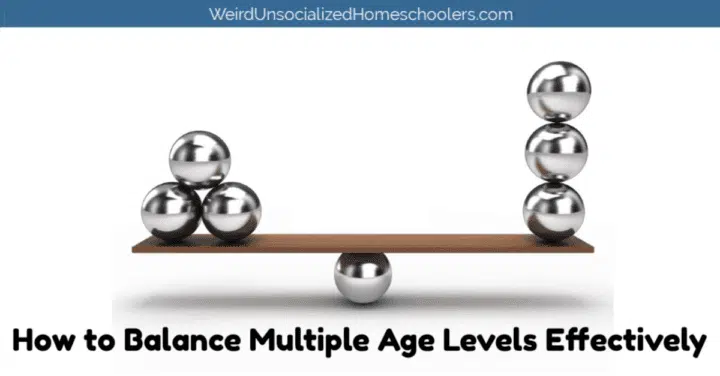How to Balance Multiple Age Levels Effectively
It can be challenging to balance multiple age levels when you homeschool. These practical tips from Sara can help you achieve that delicate balance. #homeschool #homeschooling
If you homeschool a wide age-range of children, you know that it is challenging trying to balance multiple age levels. Between keeping the older children challenged to teaching the youngest kids how to read, you’re maintaining a delicate balance.
I know. I’ve been walking that tightrope for most of the last decade!

If you’re struggling with homeschooling a wide age-span, try some of my best tips for balancing multiple age levels.
Plan Tutoring Time for Each Child
The first rule to balancing different age levels is to realize you can’t combine everything. For example, it’s best to complete skill subjects separately. The trick is to plan 30 minutes of tutoring time per child.
That gives you time to:
- teach the math lesson, review grammar, or test spelling
- laugh over a silly reading lesson.
- review the quadratic equation with a teenager.
This way, you can place your children at their level and let them progress at their own speed, one of the most significant benefits to homeschooling!
Devote Fridays to High School
Most high school teenagers don’t need a daily tutoring time with mom. They can work towards a weekly or biweekly class time instead.
Concentrating on my younger children Monday through Thursday while my high school teenager completes his assignments has worked well for me this year. Of course, I answer any questions that come up and touch base daily.
Fridays are devoted to high school.

My teenage son and I sit down to discuss literature and history. We do a quick review of his science lessons. I grade tests and walk through missed questions with him.
It’s the perfect method to balance the needs of my high school teenager with those of his younger siblings. They get the attention and daily teaching they need from me, and he learns to work towards due dates and has time devoted entirely to his educational needs.
Teach Kids to Be Independent
Completing their school work independently is one of the earliest lessons I teach my kids.
Quite frankly, little 5- and 6-year-olds need you there the entire time. So keep their school day short enough to fit into the time you have to sit with each of them.
As kids grow older (7- and 8-year-olds), begin assigning some independent work. I start with a drill sheet. Once my child is working, I get up and tidy something in the room. Do not leave the room! At this point, your kids still need you close by to keep them on track.
After a while, my kids are adept at working without me hovering over every pencil stroke.
Then, I start leaving the room for a few minutes. I’ll move laundry from the washing machine to the dryer or change the baby’s diaper. Don’t go for more than 3-5 minutes. At this stage kids need you to keep them on track.

After a while, I lengthen the time I’m out of the room. Often the kids begin asking if they can start their school ‘early’ without me. So I divide their studies into independent work and mom work, and they complete their independent work for me to check later.
Combine Within Age Levels
If you happen to have kids in the same age level, combine them whenever possible.
I love combining my high schoolers in English. They read and discuss the books with me before they go off and write their own papers. I’m juggling one book instead of two.
The same goes for middle school. Combine your 6th, 7th, or 8th graders into the same history or science curriculum.
Elementary school is easier to combine the content subjects. You can read aloud from history and science books first thing in the morning. Not only will you have a gentle start to the day, but you’ll stop feeling guilty for skipping science!
Be careful about trying to combine widely different ages. You still need to meet the needs of each child efficiently.
I found trying to combine elementary and high school wasn’t worth the time and energy required. It’s easier to keep them separate than adjusting a curriculum to fit that wide a range.
Keep the Family on the Same Topics
Balancing three different age levels is easier when you keep the family on the same topic. For instance, you can have all your kids studying Ancient Greece at the same time. Each child reads age-appropriate books and writes papers at his or her own level.
And you’re not going crazy trying to deal with three different topics!
I tried that once. Trying to teach one child about Ancient Rome, another about the Crusades, a third about the Mayflower, and a fourth about World War II was insane.
So keep the kids studying the same broad topic but use resources at their levels. Best of all, you can combine the kids for large projects, plays, and field trips!

Focus on Diligence
It’s easy to get drawn into if-onlies.
If only I didn’t need to hold the baby 24/7, I’d get so much more done.
If only the kids could finish their work independently, we’d get finished so much faster!
But homeschooling isn’t about having the perfect homeschool day. That rarely happens. You’ll have many good days, a few great days, and quite a few bad homeschool days. But you’ll rarely have a perfect homeschool day.
So when you’re balancing multiple age levels, focus on diligence, not perfection.
Sit down with your kids and do your best. Don’t worry if you need to repeat the same lesson three days in a row. Your child will eventually learn the lesson and move forward.
Don’t worry if the science experiment was a colossal failure. You didn’t burn the house down!
Homeschool days rarely go as planned. That’s okay. Focus on diligence.
As you balance multiple age levels, keep in mind that you’re slowly filling your children’s cups with memories, knowledge, and skills. It’s sitting down together that counts. Enjoying long conversations over tea and cookies. Creating a cell model out of jello and candy. And reading together on the couch.
Do you homeschool multiple age and ability levels? What tips would you add?





